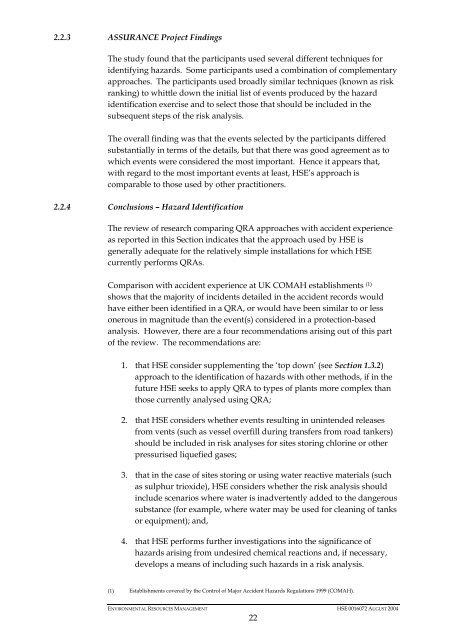A review of HSE's risk analysis and protection-based analysis ...
A review of HSE's risk analysis and protection-based analysis ...
A review of HSE's risk analysis and protection-based analysis ...
Create successful ePaper yourself
Turn your PDF publications into a flip-book with our unique Google optimized e-Paper software.
2.2.3 ASSURANCE Project Findings<br />
The study found that the participants used several different techniques for<br />
identifying hazards. Some participants used a combination <strong>of</strong> complementary<br />
approaches. The participants used broadly similar techniques (known as <strong>risk</strong><br />
ranking) to whittle down the initial list <strong>of</strong> events produced by the hazard<br />
identification exercise <strong>and</strong> to select those that should be included in the<br />
subsequent steps <strong>of</strong> the <strong>risk</strong> <strong>analysis</strong>.<br />
The overall finding was that the events selected by the participants differed<br />
substantially in terms <strong>of</strong> the details, but that there was good agreement as to<br />
which events were considered the most important. Hence it appears that,<br />
with regard to the most important events at least, HSE’s approach is<br />
comparable to those used by other practitioners.<br />
2.2.4 Conclusions – Hazard Identification<br />
The <strong>review</strong> <strong>of</strong> research comparing QRA approaches with accident experience<br />
as reported in this Section indicates that the approach used by HSE is<br />
generally adequate for the relatively simple installations for which HSE<br />
currently performs QRAs.<br />
Comparison with accident experience at UK COMAH establishments (1)<br />
shows that the majority <strong>of</strong> incidents detailed in the accident records would<br />
have either been identified in a QRA, or would have been similar to or less<br />
onerous in magnitude than the event(s) considered in a <strong>protection</strong>-<strong>based</strong><br />
<strong>analysis</strong>. However, there are a four recommendations arising out <strong>of</strong> this part<br />
<strong>of</strong> the <strong>review</strong>. The recommendations are:<br />
1. that HSE consider supplementing the ‘top down’ (see Section 1.3.2)<br />
approach to the identification <strong>of</strong> hazards with other methods, if in the<br />
future HSE seeks to apply QRA to types <strong>of</strong> plants more complex than<br />
those currently analysed using QRA;<br />
2. that HSE considers whether events resulting in unintended releases<br />
from vents (such as vessel overfill during transfers from road tankers)<br />
should be included in <strong>risk</strong> analyses for sites storing chlorine or other<br />
pressurised liquefied gases;<br />
3. that in the case <strong>of</strong> sites storing or using water reactive materials (such<br />
as sulphur trioxide), HSE considers whether the <strong>risk</strong> <strong>analysis</strong> should<br />
include scenarios where water is inadvertently added to the dangerous<br />
substance (for example, where water may be used for cleaning <strong>of</strong> tanks<br />
or equipment); <strong>and</strong>,<br />
4. that HSE performs further investigations into the significance <strong>of</strong><br />
hazards arising from undesired chemical reactions <strong>and</strong>, if necessary,<br />
develops a means <strong>of</strong> including such hazards in a <strong>risk</strong> <strong>analysis</strong>.<br />
(1) Establishments covered by the Control <strong>of</strong> Major Accident Hazards Regulations 1999 (COMAH).<br />
ENVIRONMENTAL RESOURCES MANAGEMENT HSE 0016072 AUGUST 2004<br />
22

















